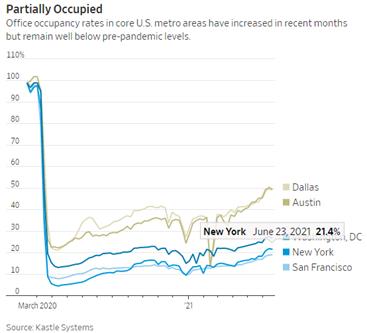(MENAFN- iCrowdNewsWire) Thanks largely to the work from home (WFH) policies of the pandemic era, there's now a new way of working in the corporate world. And it does not include having unlimited number of desks, cubicles, offices, and meeting rooms. In fact, it's very likely that, as the new work paradigm evolves, when someone says“I have an appointment scheduled at my office” – that statement will have a whole new connotation. Why? Because your employees may no longer make appointments in“their office”. They could very well be using appointment scheduling software to book sessions somewhere else!
Read on to understand why this new work paradigm is significant for you, and what you should do now, to prepare for the inevitable shift.
Read on to understand why this new work paradigm is significant for you, and what you should do now, to prepare for the inevitable shift.
The Changing Face and Place of Work
The writings on the wall: The demand for physical offices and meeting spaces is in decline. More corporations are downsizing their real estate footprints, and saving on physical office costs. Giant corporations, like Sun Microsystems , have saved over $24-million in annual real estate-related costs by downsizing their physical offices. And that's not an exclusive trend to technology companies either. Banking giant American Express is proud of it's annual $10 to $15-million savings from following a similar strategy.

The shifting trend, of re-thinking how businesses use traditional office spaces, is seen right across the U.S. The Mecca of corporate America – New York – recently only had 21.4% pre-pandemic office occupancy rate.
So, what does this mean? Well, the changing face of“offices”, and the evolution of workplaces has changed when and how appointments and meetings take place. And, the prominent use of appointment software makes it easier, for small businesses and large corporations alike, to evolve and adapt to these changing business models. Yet, at the same time, the changing face and place of workspaces isn't making a dent on flexibility.
Meetings and Appointments to Go
The numbers show that businesses have dramatically reduced the number of physical office space available to employees. But what about meetings, presentations and inter and intra-team brainstorming? Does this mean that businesses have eliminated or significantly cut-down on these vital activities?
Hardly! Now empowered by new and improved appointment and office scheduling tools, it's pretty much business as usual. While many organizations, like digital marketplace Shopify , encourage their employees to use a“digital-by-default” approach to work, others , including bankers Citibank, and financial mogul Goldman Sacs, encourage employees to get“back to the office”.
Two different approaches to the challenge of returning to“normal”. One may forgive readers for asking:
- If you go“digital by default”, why do you need office real estate?
- If you go back to work at the office, how can you cut-down on physical office space?
- What about COVID-related cleaning and disinfection protocols in physical spaces?
Well, that's where businesses leverage their feature-rich appointment scheduler to help them. No one says 100% virtual meetings are efficient. And, given the ongoing global health crisis, no one is enforcing 100% in-person work. Instead, with the help of intelligent appointment and meeting scheduling tools and apps, the world has arrived at an efficient balanced solution.
Happy Medium
The two approaches, digital-by-default, and“back into the office” might seem mutually exclusive to any plans to lighten physical office footprints. However, with cutting-edge meeting and scheduling software, businesses around the world have implemented a balanced approach to getting“back to normal”.
DIGITAL-BY-DEFAULT, BUT NOT ONLY…
The“digital-by-default” policy doesn't preclude having in-person meetings, or prevent employees from scheduling appointments at an office. Although online and virtual meetings and work sessions are the default, they are by no means the only way these companies do businesses. Some appointments are just too complex, and some meetings extremely critical, to schedule remotely.
- Where possible, and by default, employees will work, collaborate, and work remotely
- When unavoidable, businesses make limited and designated physical office spaces available for staff, clients, and business partner use
This is a“happy medium” that makes the default policy viable and practical. It's also one that enables business leaders to drastically reduce their physical office footprints. But proper scheduling and coordination is key.
BACK TO THE OFFICE…BUT WHERE?
Like the“digital-by-default” model, the“back to the office” approach too has its challenges. How do corporations plan on cutting down their real estate footprints – by up to 30% in some instances – and still mandate employees back to work? It's an interesting paradigm, and one that might challenge most facility managers, especially now, when social distancing and COVID-related health and safety protocols rule supreme.
- These businesses have cut-down on office square-footage, but not many of them have dramatically down-sized their staffing
- Employees, managers, clients, and other business partners don't just head into the office to have meetings or consultation sessions
- Instead, employees use their scheduling app , integrated with the corporate communication software and email clients, to better manage in-person appointments and meetings
Using appointment scheduling technology facilitates better planning, scheduling, and coordination among broad sets of business stakeholders. More importantly, it helps organizations arrive at a“happy medium” between reduced office space and maintaining in-person business events.
Room Scheduling at its Best
Clearly, we've entered a brand-new work world where physical offices are no longer at the forefront of a workday. Businesses, while cutting down on their real estate holdings, have implemented new ways to work, including desk sharing, workplace hoteling and revolving use of meeting rooms and conference spaces.
MENAFN11092021003318003403ID1102777726
Legal Disclaimer:
MENAFN provides the information “as is” without warranty of any kind. We do not accept any responsibility or liability for the accuracy, content, images, videos, licenses, completeness, legality, or reliability of the information contained in this article. If you have any complaints or copyright issues related to this article, kindly contact the provider above.